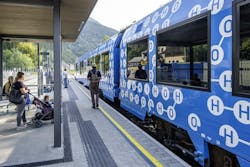Caterpillar, Cummins Move on Hydrogen for Trains
Caterpillar and Cummins are working separately to put hydrogen to work in locomotives.
Caterpillar and Chevron have a collaboration agreement to develop hydrogen demonstration projects in transportation and stationary power applications, including prime power. The goal of the collaboration is to confirm the feasibility and performance of hydrogen for use as a commercially viable alternative to traditional fuels for line-haul rail and marine vessels, according to a joint press release from the companies. The collaboration also seeks to demonstrate hydrogen’s use in prime power.
Linked to the collaboration, and facilitated by Progress Rail, a Caterpillar company, the parties also agreed to demonstrate a hydrogen-fueled locomotive and associated hydrogen-fueling infrastructure. Work on the rail demonstration will begin immediately at various locations across the United States.
“Through Chevron New Energies, Chevron is pursuing opportunities to create demand for hydrogen—and the technologies needed for its use—for the heavy-duty transportation and industrial sectors, in which carbon emissions are harder to abate,” said Jeff Gustavson, president of Chevron New Energies, in a prepared statement. “Our collaboration with Caterpillar is another important step toward advancing a commercially viable hydrogen economy.”
“As we work to provide customers with the capability to use their desired fuel type in their operations, collaborating with Chevron is a great opportunity to demonstrate the viability of hydrogen as a fuel source,” said Joe Creed, Caterpillar group president of Energy & Transportation. “This agreement supports our commitment to investing in new products, technologies and services to help our customers achieve their climate-related objectives as they build a better, more sustainable world.”
Cummins powers French locomotives with Alstom
Cummins is currently powering hydrogen trains in commercial operation. In 2016, Cummins partnered with customer Alstom, a French railway equipment manufacturer, to engineer, supply, and integrate the hydrogen fuel cell solution in its Coradia iLint trains. The trains entered commercial service in 2018 and can carry up to 150 seated passengers and 150 standing passengers. They will start operating later this year through 2022 in Lower Saxony, and there is interest from other German federal states and other European countries to use the trains for non-electrified tracks.
Cummins lists five reasons why hydrogen has a place in the future of the railway industry.
Trains powered by hydrogen have zero emissions at the point of use. The power required for the train’s systems is supplied via a fuel cell, which generates energy by combining the hydrogen stored on the train’s roof with oxygen in the air. There are no emissions of carbon dioxide in this process. They are also efficient: fuel cells are up to three times more efficient than internal combustion engines.
Hydrogen trains can be deployed anywhere and retrofitted into existing trains and lines. The majority of lines across Europe and the U.S., particularly rural lines and lines with little consumer demand, are yet to be converted to carry electric trains. Hydrogen trains represent a cost-effective alternative that doesn’t sacrifice efficiency or emissions. They can simply run on existing rail infrastructure without the high cost of adding electrification. Cummins fuel cell solutions are flexible and scalable in their configuration and can be customized to fit customers’ needs optimally.
Hydrogen fuel cell trains have an exceptionally long range of up to 1000 kilometers at a maximum speed of 140km/h between refueling—ten times farther than battery powered electric trains. And refueling is quick: hydrogen powered trains can run for 18 or more hours after less than 20 minutes of refueling.
Fuel cells are cost effective and low maintenance. The total lifetime cost of ownership is already comparable for trains running on diesel or electrified lines, according to a report by consulting firm Roland Berger. There is a long asset life compared to electrification, and repairs are often as simple as swapping out one plug-in component for another.
Trains powered by hydrogen are quiet and comfortable. Hydrogen provides a smooth driving experience and emits low noise levels due to the exhaust being only steam and condensed water. This is especially important in urban areas where noise pollution is an issue.
Sources: Cummins, Catepillar, Chevron
